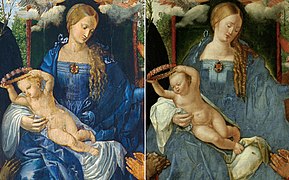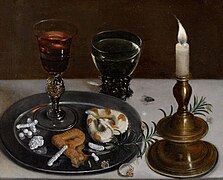
Musca depicta ("painted fly" in Latin; plural: muscae depictae) is a depiction of a fly as a conspicuous element of various paintings. The feature was widespread in 15th- and 16th-century European paintings, and its presence has been subject to various interpretations by art historians.
Interpretations

James N. Hogue, writing in the Encyclopedia of Insects, lists the following reasons behind musca depicta: as a jest; to symbolize the worthiness of even minor "objects of creation"; as an exercise in artistic privilege; as an indication that the portrait is post mortem; and as an imitation of works of previous painters. Many art historians argue that the fly holds religious significance, carrying connotations of sin, corruption or mortality.
Another theory is that Renaissance artists strove to demonstrate their mastery in portraying nature, with André Chastel writing that musca depicta became as an "emblem of the avant-garde in painting" at the time. There exist several anecdotes from the biographies of various artists who, as apprentices, allegedly painted a fly with such skill as to fool their teacher into believing it was real. Well-known examples are those about Giotto as an apprentice of Cimabue and Andrea Mantegna and his master Francesco Squarcione. Kandice Rawlings argues that since these anecdotes were widespread, they contributed to the humorous interpretation of some trompe-l'œil flies.
Commenting on the Czech portrait of Francysk Skaryna, Ilya Lemeshkin brings attention to the fly painted on a corner of a page of Skaryna's Bible. He argues that the function of the fly is to secularize the image – in other words, to indicate that the depicted object is not a cult object to be venerated, but simply a painting.
Andor Pigler surmises that the painted fly served an apotropaic function, that is to serve as a type of magic intended to turn away harm or evil influences, as in deflecting misfortune or averting the evil eye. Kandice Rawlings challenges this notion, writing that Pigler fails to take into account other traditions associated with flies.
Trompe-l'œil fly
Both Konečný, writing about Dürer's Feast of the Rosary (copy), and Lemeshkin, writing about Skaryna's portrait, observe the flies painted in each do not exactly "sit" on the underlying painted objects, but rather sit above them. Based on this observation, as well as noting the disproportionately large relative size of the flies compared with the other depicted objects, Konečný argues that this was intended as a trompe-l'œil (illusion), that the fly sits on the painting. He also remarks that the fly in the Portrait of a Carthusian (pictured above) serves to intensify the illusion of the trompe-l'œil frame. The Portrait of a Carthusian, dated about 1446, is the earliest known example of panel painting with a trompe-l'œil fly.
Trompe-l'œil flies are recognized in over twenty Netherlandish, German, and north Italian paintings dated between 1450 and the 1510s, and are analysed by André Chastel in a book eponymously dedicated to musca depicta. Of them, eight are portraits, thirteen are religious miniatures, and only two are large-size works. Chastel remarks that trompe-l'œil flies were a passing fad, with artists later having found other ways to demonstrate their skill.
In popular culture
The musca depicta is a recurring topic in the 2019 film, The Burnt Orange Heresy. The main character, an art dealer, explains to a woman he meets that it signifies corruption.
Gallery
-
 Willem van Aelst, Still Life with Hunting Equipment
Willem van Aelst, Still Life with Hunting Equipment
-
 Balthasar van der Ast, Basket of Fruits
Balthasar van der Ast, Basket of Fruits
-
 Abraham van Calraet, Stilleven met vruchten en schelpen
Abraham van Calraet, Stilleven met vruchten en schelpen
-
 Carlo Crivelli, Madonna and Child
Carlo Crivelli, Madonna and Child
-
 comparison of Albrecht Dürer's versions of the Feast of the Rosary
comparison of Albrecht Dürer's versions of the Feast of the Rosary
-
 Clara Peeters, Still life with dainties, rosemary, wine, jewels and a burning candle
Clara Peeters, Still life with dainties, rosemary, wine, jewels and a burning candle
References
- ^ Hogue, James N. (2009). "Cultural Entomology". In Resh, Vincent H.; Cardé, Ring T. (eds.). Encyclopedia of Insects (2nd ed.). Academic Press. p. 242. ISBN 978-0-08-092090-0. Retrieved October 17, 2021.
- Hall, James (2018). "Fly". Dictionary of Subjects and Symbols in Art (Rev. ed.). Routledge. p. 130. ISBN 9780429962509. Retrieved October 17, 2021.
- ^ Connor, Steven (n.d.). "Flysight: The Painter and the Fly". StevenConnor.com. Retrieved October 17, 2021.
- ^ Chastel, André (1994). Musca depicta. Translated by Aghion, Carole; Carion, Anne. Milan: F. M. Ricci. ISBN 9788821621079. Retrieved October 18, 2021.
- ^ Konečný, Lubomír (2006). "Catching an Absent Fly" (PDF). In Kotková, Olga (ed.). Albrecht Dürer: The Feast of the Rose Garlands, 1506-2006. Národní galerie v Praze. p. 50. ISBN 9788070353325. Retrieved October 17, 2021.
- ^ Rawlings, Kandice (January 1, 2008). "Painted Paradoxes: The Trompe-L'Oeil Fly in the Renaissance". Athanor. 26 (2008): 7–13. Retrieved October 17, 2021.
- ^ Lemeshkin, Ilya (2019). Груша, Аляксандр Іванавіч (ed.). Францыск Скарына: новыя даследаванні (in Russian). Belaruskai︠a︡ navuka. p. 75. ISBN 978-985-08-2415-8. Retrieved October 18, 2021.
- Pigler, Andor. "La mouche peinte: un talisman". Bulletin du Musee Hongrois des Beaux Arts (in French). Vol. 24 (1964). Budapest. pp. 47–64.
- Chastel, as commented by Rawlins, op. cit
- Verniere, James (August 7, 2020). "'Burnt Orange' a deliciously nasty shade of noir". Boston Herald. Retrieved October 17, 2021.
But he adds a tiny fly image to each painting, a metaphor for sin and evil. For this, his masters send him to the gas chamber. You can be sure flies will figure prominently in the rest of this dark fable.
Further reading
- Kemp, Cornelia (2003) Fliege, In: Reallexikon zur deutschen Kunstgeschichte, Pt. 9 pp. 1196–1221
- The section Trompe l'oeil of the book lists many paintings with musca depicta, classified into categories "Portrait painting", "Madonna", "Still Life", etc.
- Weixlgärtner, Arpad, "Die Fliege auf dem Rosenkranzfest" (1928) - In: Mitteilungen der Gesellschaft für vervielfältigende Künste (1928) pp. 20-25
- Konečný states that this text was first to bring an attention to the fly as a notable difference between the classical version of the Feast of the Rosary and its copies. According to Konečný, Weixlgärtner is the only author who gave a detailed description of the fly, identifying it as blue bottle fly, rather than a common housefly.
| Human interactions with insects | |||||||||||||||
|---|---|---|---|---|---|---|---|---|---|---|---|---|---|---|---|
| Aspects of insects in culture |
| ||||||||||||||
| Pioneers |
| ||||||||||||||
| Concerns | |||||||||||||||
| Categories, templates | |||||||||||||||